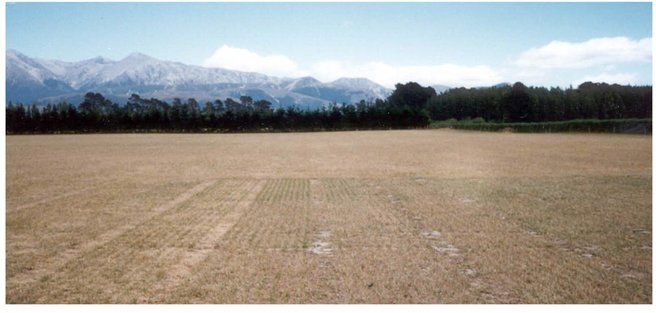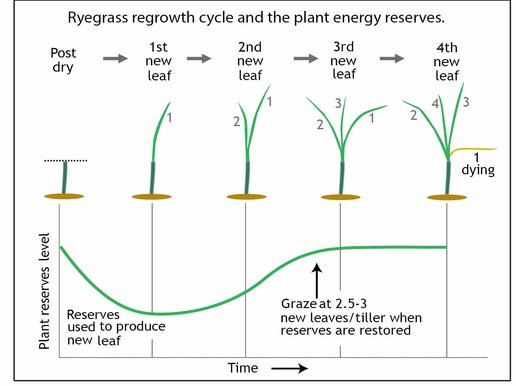Perennial ryegrass persistence
Summary
- Persistence is the continued yield of the sown ryegrass over time (years). Ryegrass persistence varies widely, depending on a range of factors including management, climate, pests, cultivar and endophyte.
- This section covers management to improve ryegrass persistence.

Ryegrass is well adapted to being grazed by animals, and can survive indefinitely as can be seen by the productive old pastures (30 years plus) found on many farms. In most situations, however, pasture performance drops over time and reaches a stage where it performs poorly or has a high weed content, and renewal is needed.
Pasture persistence varies throughout New Zealand and is generally lower in summer dry areas and higher in summer moist areas. However, persistence varies widely between farms in the same area, showing the large effect management has.
What affects persistence?
These can all affect ryegrass plants and reduce persistence:
- Summer dry conditions
- High temperature
- Poor soil fertility
- Pests and diseases
- Grazing management
- Pugging in wet conditions
- Plant genetics (cultivar, ploidy, density)
- Endophyte
Typically a pasture is significantly damaged when 2-3 of these factors coincide, having an additive effect, e.g. pest attack coupled with overgrazing during summer dry conditions.
Farm system
Achieving good ryegrass persistence needs to start at a farm system level, matching farm policies and objectives to the climate (and variability) and soils. These can include the type of livestock run, stocking rate, calving or lambing date, trading policies, and use of crops and supplements.
For example, in potentially summer dry areas farmers can have a range of policies to both decrease feed demand (e.g. running trading stock that can be sold, grazing off- farm, selling lambs store, once-a-day milking) and increasing feed supply (e.g. summer crops, supplements).
Pasture species
It should be noted that perennial ryegrass does not suit all situations. For example under a low 400 mm rainfall without irrigation lucerne, cocksfoot or pasture brome are better suited.
Soil fertility
Optimum soil N, P, K, and S and soil pH are essential. And, moisture permitting, N fertiliser can be used in late spring/early summer to increase pasture cover in summer to help protect summer post-grazing residuals.
Summer crops
Summer crops provide feed which can be used to compensate for reduced summer ryegrass growth in dry conditions. The increased feed supply will help reduce the risk of overgrazing pasture, and therefore improve persistence.
Supplements
Supplements are similar to summer crops, providing a buffer of feed to help reduce overgrazing and improve pasture persistence.
Supplements have two benefits over summer crops. First, they can be stored and used when required. Second, their quantity is known in advance (whereas summer crops are affected by climate, and in dry years when pasture growth is poor crop yields are typically low too).
Pasture establishment
Establishment strongly influences persistence. Controlling problem weeds well, creating a good seedbed, and good management over the first 12 months of a new pasture set up a strong, healthy pasture that is better able to withstand adverse conditions (see pasture renewal chapter).
Grazing management
Prolonged moisture stress combined with overgrazing, heat and sometimes insect damage cause the greatest persistence problems in NZ. Apart from irrigation, farmers have no control over moisture stress, but good grazing management can significantly improve persistence, which can be seen from the significant differences in persistence between farms in the same district. Each season brings different challenges.
Spring management
Key challenges
- Preparing for a dry
- Dealing with feed
- Maintaining feed quality (not letting dead matter build up).
Strong, healthy ryegrass plants will survive dry conditions better than those which are weak. So farmers should aim for pastures with robust, well grown plants prior to (a possibly dry) summer.
For perennial ryegrass, management through spring is particularly important, because plants are vulnerable to stress as they change from vegetative to reproductive and back to vegetative growth. Production of new tillers is highest before flowering during mid-spring, and again immediately post-flowering in early summer, and survival of these new (daughter) tillers is critical to persistence.
During this period pasture covers should be maintained at 1000-3000 kg DM/ha to maximise net pasture production. Overgrazing (<1000 kg DM/ha) can weaken pasture plants, while undergrazing (>3000 kg DM/ha) tends to produce more open pastures with fewer tillers, making them more vulnerable to stress. In dairy systems, the post grazing pasture residual should be kept at a height of 4-6 cm.
A rotational grazing interval based on leaf re-growth stage will also optimise the persistence of perennial ryegrass. Grazing at 2.5 - 3 leaves per tiller allows for plant energy reserves to be replenished, whereas grazing too early (< 2 leaves/tiller are present) or too late (> 3 leaves/tiller) weakens the pasture.

These practices meet the nutritional needs of the animals, maximise pasture growth, and help set up strong ryegrass pastures, before a potentially dry summer.
As late spring is usually a period of surplus pasture growth, strategies to help in achieving good grazing include removing paddocks from grazing to sow crop; making silage or hay; mowing pasture pre or post grazing or purchasing extra stock.
Summer management
Key challenges
- Avoiding
- Increasing feed supply or reducing
Short periods of moisture stress are common. The main problem for ryegrass persistence is extended dry periods which might last for several months. During these times, growth is limited, and the pasture management focus is simple: maintain a strong pasture which will survive and re-grow once rain comes.
The biggest risk during extended dry periods is overgrazing, resulting from the tension between continued animal feed requirements and poor pasture growth. Overgrazing can kill plants and allow invasion of weeds.
Farmers need systems in place to avoid overgrazing, or limit it to certain parts of the farm. A key tactic is on-off grazing, where animals are removed from the pasture when the desired post-grazing residual has been achieved, and put onto to a feed pad, crop stubble, lower value pasture, or paddock(s) earmarked for renewal.
Strategies to increase feed supply (e.g. supplements and summer crops) or decrease feed demand (e.g. selling trading stock or culls, once-a-day milking) can be used to both feed animals and protect pastures from overgrazing through dry periods.
Autumn management
Key challenges
- Allowing pastures to recover following any extended dry
- Dealing with insect
Once pastures receive significant rainfall, they must be allowed to recover before grazing. Farmers should continue their dry weather management strategies while pastures slowly start growing again.
Ryegrass pastures should only be grazed when ryegrass plants have produced 2.5-3 leaves per tiller, when plant energy reserves are replenished for good re-growth as illustrated in the figure on the previous page. Grazing prior to this may weaken and kill recovering pastures.
If grass grub or porina are likely to be a problem an early application of insecticide should be used (during February/March). Mob stocking/heavy rolling when soil is damp can help to reduce grass grub population.

